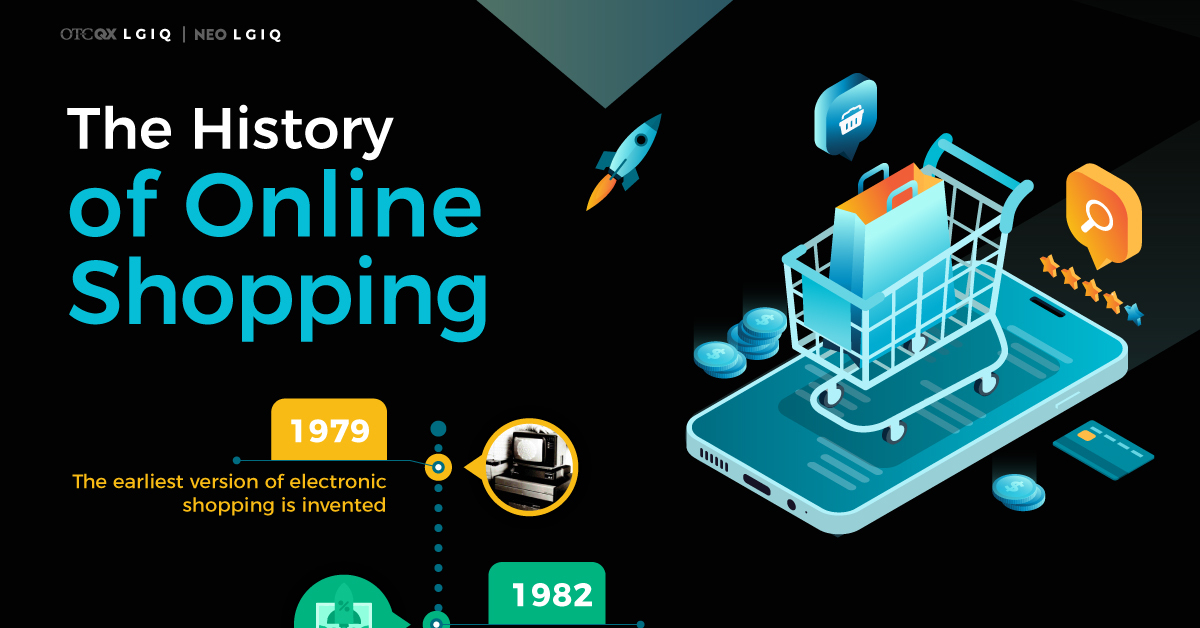Timeline: Key Events in the History of Online Shopping
The following content is sponsored by Logiq

The History of Online Shopping
For many, it can be hard to remember the days when online shopping wasn’t an option. Yet, despite its prevalence now, online shopping is a relatively new phenomenon.
This graphic, presented by Logiq, outlines the brief history of online shopping and how it has evolved over the last few decades. We’ll also touch on how companies can get ahead in this rapidly evolving space and what it takes to remain competitive in today’s market.
Timeline: From the Late 70s to Present Day
According to BigCommerce, the first inklings of online shopping began in England, back in the late 1970s.
1970s: The Early Days
In 1979, the English inventor Michael Aldrich invented a system that allowed consumers to connect with businesses electronically. He did this by connecting a consumer’s TV to a retailer’s computer via a telephone line.
His invention was one of the first communication tools that allowed for interactive, mass communication—but it was costly, and it didn’t make sense financially for most businesses until the Internet became more widespread.
1980s: Bulletin Boards
By 1982, the world’s first eCommerce company launched. The Boston Computer Exchange (BCE) was an online marketplace for people to buy and sell used computers.
The launch of BCE predates the advent of the World Wide Web, and because of this, the company operated on a dial up bulletin board system.
1990s: The Big Dogs Begin to Emerge
By the mid-90s, the Internet had become an established hub for global communication and connection. In 1995, the most popular web browser at the time, Netscape, had around 10 million users worldwide.
That same year, Jeff Bezos launched Amazon, which at the time functioned as an online book marketplace. The company saw early signs of success—within 30 days of launching, it was shipping internationally to 45 different countries.
A few years later, an online payment system called Confinity—now known as PayPal—was born.
2000s: Monetization Goes Mainstream
When the Internet’s novelty started to wear off around the early 2000s, monetization methods and platforms started to become more sophisticated.
In 2000, Google introduced Google AdWords as an online advertising tool for businesses to promote their products. This ushered in the era of pay-per-click advertising.
Five years later, Amazon introduced its Prime membership package, which offered members perks like free rapid shipping and exclusive discounts. Prime users were (and still are) charged an annual membership fee.
2010s: That Escalated Quickly
By the 2010s, eCommerce rapidly started to pick up speed. In 2010, for the first time in online shopping history, U.S. online sales during Cyber Monday surpassed $1 billion.
Around the same time, the launch of new digital payment tools helped add fuel to the fire. For instance, the launch of Apple Pay in 2014 made it easy for consumers to pay for products directly from their iPhones.
Present day: The Future is Bright
Amidst the global pandemic, businesses were forced to close their brick-and-mortar stores, and lockdown restrictions drove consumers online. By May 2020, eCommerce sales had reached $82.5 billion, a 77% rise year-over-year.
And while the world has started to open up again, online shopping is expected to continue growing and expanding its market share—by 2023, online shopping is expected to make up 22% of total retail sales across the globe.
Marketplace Monopoly
While the future looks promising for online shopping, it’s important to note that historically, online sales haven’t been evenly distributed across the board. In fact, in 2020, just five retailers made up more than 50% of total online retail sales in America.
| Vendor | % of total U.S. retail eCommerce Sales (2020) |
|---|---|
| Amazon | 39% |
| Walmart | 5.8% |
| eBay | 4.9% |
| Apple | 3.5% |
| The Home Depot | 2.1% |
| Other (roughly 1.3 million companies) | 44.7% |
With the online world constantly evolving, it can be challenging for small to midsize businesses to keep up and remain competitive with the big players. That’s why companies like Logiq exist.
Logiq provides businesses with simplified eCommerce solutions, to help them level up their eCommerce game and stay ahead of the rapidly changing world of online shopping.
-

 Sponsored3 years ago
Sponsored3 years agoMore Than Precious: Silver’s Role in the New Energy Era (Part 3 of 3)
Long known as a precious metal, silver in solar and EV technologies will redefine its role and importance to a greener economy.
-

 Sponsored7 years ago
Sponsored7 years agoThe History and Evolution of the Video Games Market
Everything from Pong to the rise of mobile gaming and AR/VR. Learn about the $100 billion video games market in this giant infographic.
-

 Sponsored8 years ago
Sponsored8 years agoThe Extraordinary Raw Materials in an iPhone 6s
Over 700 million iPhones have now been sold, but the iPhone would not exist if it were not for the raw materials that make the technology...
-

 Sponsored8 years ago
Sponsored8 years agoThe Industrial Internet, and How It’s Revolutionizing Mining
The convergence of the global industrial sector with big data and the internet of things, or the Industrial Internet, will revolutionize how mining works.


